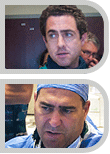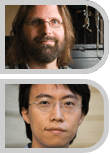Faculty Research & Honors
Selected Faculty Research
- Forming Earth’s Crust
- Christopher Andronicos, Earth and Atmospheric Sciences
- How Big a Bacterium?
- Esther R. Angert, Microbiology
- Fish–Speak
- Andrew H. Bass, Neurobiology and Behavior
- Intra–Arterial versus Intravenous
- John A. Boockvar, Neurological Surgery, Howard Riina, Neurological Surgery/Neurology/Radiology, Weill Cornell Medical College
- Emotions and Memories
- Charles Brainerd and Valerie Reyna, Human Development
- Apples on the Fast Track
- Susan K. Brown, Horticultural Sciences, Geneva
- A New Maize Genetics Map
- Edward S. Buckler, Plant Breeding and Genetics
- A Vaccine for Johne’s Disease
- Yung-Fu Chang, Population Medicine and Diagnostic Sciences
- Observing Single Catalytic Events
- Peng Chen, Chemistry and Chemical Biology
- Superconductivity at Room Temperature?
- J. C. Séamus Davis, Physics
- A New Genetic Engineering Technique
- Matthew DeLisa, Chemical and Biomolecular Engineering
- Switching Off
- Scott D. Emr, Weill Institute for Cell and Molecular Biology
- Light Moves Molecules
- David Erickson, Mechanical and Aerospace Engineering, Michal Lipson, Electrical and Computer Engineering
- Stress and Cognitive Development
- Gary W. Evans, Design and Environmental Analysis
- Night Vision, an Evolutionary Quirk
- Barbara L. Finlay, Psychology
- Cancer Cell Growth in 3-D
- Claudia Fischbach-Teschl, Biomedical Engineering
- An Ultrafast Oscilloscope
- Alexander Gaeta, Applied and Engineering Physics, Michal Lipson, Electrical and Computer Engineering
- Price and the Perception of Quality
- Ori Heffetz, Johnson Graduate School of Management
- ASL Cell Phones
- Sheila S. Hemami, Electrical and Computer Engineering
- The Mating Duet
- Ronald R. Hoy, Neurobiology and Behavior, Laura C. Harrington, Entomology
- From Flickr to Online Travel Guidebook
- Daniel P. Huttenlocher, Computing and Information Science, David A. Lifka, Cornell Center for Advanced Computing
- Targeting an Enzyme for Curbing Alzheimer’s Disease
- Costantino Iadecola, Neurology and Neuroscience, Weill Cornell Medical College
- Spillover Effect in Teaching
- C. Kirabo Jackson, Industrial and Labor Relations
- The Language of Design
- Jan Jennings, Design and Environmental Analysis
- Marker for Breast Cancer Metastasis
- Joan G. Jones, Pathology, Weill Cornell Medical College
- Innovations Preferred Early
- Sheryl E. Kimes and Rohit Verma, Hotel Administration
- Tracking the News Cycle
- Jon M. Kleinberg, Computer Science
- Cardiac Stem Cells
- Michael I. Kotlikoff, Biomedical Sciences
- Computer, Observe and Find
- Hod Lipson, Mechanical and Aerospace Engineering
- A Cloaking Device
- Michal Lipson, Electrical and Computer Engineering
- Pinpointing Genes
- John T. Lis, Molecular Biology and Genetics
- Apples and More
- Rui Hai Liu, Food Science
- DNA for Nanocircuits
- Dan Luo, Biological and Environmental Engineering, Christopher Umbach, Materials Science and Engineering, David Muller, Applied and Engineering Physics
- World’s Thinnest Balloon
- Paul L. McEuen, Physics, Jiwoong Park, Chemistry and Chemical Biology
- Birds Immortalized
- Todd McGrain, Art
- Racial Discrimination and Stress
- Anthony D. Ong, Human Development
- Nursing Home Violence
- Karl A. Pillemer, Human Development, Mark S. Lachs, Medicine, Weill Cornell Medical College
- Causing Obesity
- Ling Qi, Nutritional Sciences
- Moving from Antibiotics to Anti-infectives
- Luis Quadri, Microbiology and Immunology, Weill Cornell Medical College
- The Allergy-Cancer Connection
- Paul W. Sherman, Neurobiology and Behavior
- A Commission and a Grammy Nomination
- Roberto Sierra, Music
- First Synthetic Tree
- Abraham D. Stroock, Chemical and Biomolecular Engineering
- Stem Cells: Fruit Fly versus Mouse
- Tudorita Tumbar, Molecular Biology and Genetics
- Autism and Environmental Triggers
- Michael Waldman, Johnson Graduate School of Management, Sean Nicholson, Policy Analysis and Management
- Unzipping Single DNA Molecules
- Michelle D. Wang, Physics, John T. Lis, Molecular Biology and Genetics
- Calories and The Joy of Cooking
- Brian C. Wansink, Applied Economics and Management
- From Cornell Dots to Nanolaser
- Ulrich B. Wiesner, Materials Science and Engineering
Forming Earth’s Crust

Christopher Andronicos, Earth and Atmospheric Sciences, and research colleagues puzzled over the conditions that create granulite, a key component of the Earth’s crust. Granulite forms from moving, molten rock at a wide range of depths, but a narrow range of temperatures. The Cornell team created a mathematical computer model of the formation of granulite that explains how granulite is instead formed as the molten rock migrates upward through the crust.
How Big a Bacterium?

Esther R. Angert, Microbiology, and her research team showed how the unusually large size of the bacterium Epulopiscium sp.—roughly the size of a grain of salt—may be due to its ability to copy its genome tens of thousands of times. The bacterium lives in the gut of surgeonfish. Prior to this study, other bacteria have been known to generate multiple copies of their genomes, but only as many as a few hundred. The researchers are interested in how the process emerged in surgeonfish and how it may affect the organism’s biology.
Fish–Speak

Andrew H. Bass, Neurobiology and Behavior, and his research group found that the neural network behind sound production in vertebrates can be traced backed to the hums and grunts of fish. Cornell researchers mapped the developing brain cells in newly hatched larvae of the midshipman fish, a species known for the loud humming sounds adult males generate with their swim bladders to attract females to their nests. They compared this system to the neural circuitry behind vocalizations of amphibians, birds, reptiles, and mammals, including primates. They discovered that the complexity of networks varies, but the fundamental attributes are the same. The findings put human speech and the social communications of all vertebrates into evolutionary context.
Intra-Arterial versus Intravenous

John A. Boockvar, Neurological Surgery, Howard Riina, Neurological Surgery/Neurology/Radiology, Weill Cornell Medical College, and colleagues performed the world’s first intra-arterial (IA) cerebral infusion of Avastin (bevacizumab) directly into a patient’s malignant brain tumor. This novel intra-arterial technique, combining the latest in drug treatment and a revolutionary delivery procedure, may expose the cancer to higher doses of the drug therapy, sparing the patient common side effects of receiving the drug intravenously throughout the body.
Emotions and Memories

Charles Brainerd and Valerie Reyna, Human Development, led a study on how negative events result in more false memories than neutral events. The researchers found that negative events actually distort memory. People may not remember the details of what happened to them, but they remember that the incident was negative, and this allows them to fill in the blanks with memories of negative events that did not happen. The research will influence understandings about the accuracy of legal testimony in criminal cases and how interviews and interrogations in violent cases should be conducted.
Apples on the Fast Track

Susan K. Brown, Horticultural Sciences, Geneva, tracked new Cornell apple selections at 30 New York orchards to determine their commercial viability. The aim is to fast track grower testing of 42 advanced apple-breeding selections. Brown’s expectation of identifying two new varieties with the potential for commercialization has been realized. In the spring of 2010, two new Cornell varieties, developed by Brown, were licensed exclusively to a New York grower owned company.
A New Maize Genetics Map

Edward S. Buckler, Plant Breeding and Genetics, and research colleagues identified thousands of diverse genes in genetically inaccessible parts of the maize genome and created the first map of haplotypes—sets of linked gene variants known as alletes. The lines selected for study included a cross-section of maize varieties used for breeding, representing worldwide diversity. The haplotype map will help researchers and breeders to develop molecular markers and create new tools—previously out of reach—to improve maize varieties.
A Vaccine for Johne’s Disease

Yung-Fu Chang, Population Medicine and Diagnostic Sciences, and research colleagues developed a vaccine for Johne’s disease, which results in annual losses of $220 to $250 million for the U.S. dairy industry. The contagious, chronic, and unusually fatal bacterial infection—caused by the Mycobacterium avium subspecies paratuberculosis—primarily infects cattle, sheep, goats, and farm-raised deer, elk, lamas, alpaca, bison, and zoological wildlife. Changes in management practices were previously the only way to prevent the disease.
Observing Single Catalytic Events

Peng Chen, Chemistry and Chemical Biology, and research group developed a microscopic method for observing the behavior of single nanoparticles of a catalyst, down to the resolution of single catalytic events. They showed that some nanoparticles in a batch carry out their reactions differently and that each nanoparticle changes the speed of its catalytic reaction over time—and they measured the time scale. Nanoparticles provide a larger surface area to speed reactions, and in some cases, materials that are not catalytic in bulk become so at the nanoscale. Nanocatalysts therefore hold promise for such applications as fuel cells and pollutant removal.
Superconductivity at Room Temperature?

J. C. Séamus Davis, Physics, and his research team took new measurements revealing that high-temperature superconductors may have the potential to go even higher. These findings raise the possibility of creating room-temperature superconductors or superconductors that will work with conventional refrigeration. Superconductors conduct electricity with zero resistance—but only when cooled to very low temperatures. Recently developed materials called cuprates, consisting of copper oxide doped with other elements, superconduct up to temperatures as high as 150 Kelvins (-123°C or -253°F). Such materials could lead to far more efficient electric generators, lossless power transmission, and other energy-saving applications.
A New Genetic Engineering Technique

Matthew DeLisa, Chemical and Biomolecular Engineering invented a new genetic engineering technique—a protein readout method for cells. The technique will allow researchers to create and catalog disease-specific antibodies in the lab, revolutionizing antibody-based drug treatments for such diseases as Alzheimer’s and cancer. Inspired by nature, the method encompasses efficient readout of protein-to-protein interactions within cells. An Ithaca-based biotechnology company, Vybion Inc., negotiated an exclusive license with Cornell to use the technology, which the company is now applying to its in-house drug development and related projects.
Switching Off

Scott D. Emr, Weill Institute for Cell and Molecular Biology, and his collaborators provided a new insight into how receptors on cell surfaces turn off signals from the cell’s environment, a vital contribution to cell functions such as growth, division, and death. Their findings will improve understanding of cancer, AIDS, neurodegenerative disorders, and other illnesses, because such diseases can result when receptors go awry by failing to turn off, a function known as down-regulation.
Light Moves Molecules

David Erickson, Mechanical and Aerospace Engineering, Michal Lipson, Electrical and Computer Engineering, and research colleagues demonstrated that a beam of light can trap and move particles, including DNA molecules, as small as 75 nanometers in diameter. This application of optofluidics—using the pressure of light to move and manipulate biological molecules—could overcome the obstacle of moving materials at the nanoscale. A tiny biological sample could be carried through microscopic channels for processing. The research may lead to scientific breakthroughs such as a lab on a chip; a portable, fast-acting detector for disease organisms or food-borne pathogens; and rapid DNA sequencing.
Stress and Cognitive Development

Gary W. Evans, Design and Environmental Analysis, and research staff confirmed that the chronic stress of growing up in poverty can physiologically impact children’s brains. It can impair their working memory and diminish their ability to develop language, reading, and problem-solving skills. The study is the first to tie cognitive development to physiological stress in children living in impoverished environments. Their findings suggest that government policies and programs that aim to reduce the income-performance gap should also consider the chronic stress children experience at home.
Night Vision, an Evolutionary Quirk

Barbara L. Finlay, Psychology, and research colleagues determined that an evolutionary mechanism shows how important changes in primates’ brain structures evolve. The researchers reported that evolution appears to proceed through simple genetic changes that affect the timing of development in brain regions. Minor differences in the timing of cell proliferation can explain the large differences found in the eyes of two species of monkeys—owl monkeys and capuchin monkeys—evolving from a common ancestor. They studied the developing eyes of these species of monkeys during embryonic growth for insight into how nocturnal owl monkeys develop retinas with many more rod cells than cones, while capuchin monkeys, which are active during the day, develop more cone cells than rods.
Cancer Cell Growth in 3-D

Claudia Fischbach-Teschl, Biomedical Engineering, demonstrated that a previously underestimated protein secreted by cancer cells could be key in allowing cancer to grow and spread. Fischbach-Teschl and her research team studied the behavior of cancer cells grown in two and three dimensions. They looked at how cancer cells, binding to the material that surrounds them—called the extracellular matrix—regulate the secretion of proteins called angiogenic factors. These proteins allow tumors to develop blood-vessel networks and metastasize.
An Ultrafast Oscilloscope

Alexander Gaeta, Applied and Engineering Physics, Michal Lipson, Electrical and Computer Engineering, and research colleagues created an ultrafast oscilloscope that can plot the waveform of an optical signal with a resolution of less than a trillionth of a second. Although some current methods can measure such brief waveforms by averaging many repeating events, the new oscilloscope can capture events that happen only once in a while. Applications include analyzing intermittent glitches in fiber-optic communications and observing such fast-moving events as chemical reactions and laser fusion.
Price and the Perception of Quality

Ori Heffetz, Johnson Graduate School of Management, and research colleagues tested the link between price and consumer perceptions of quality in two food-related experiments. Contrary to previous studies, they found that higher prices did not cause the predicted higher demand for the products, but instead decreased demand. Although more expensive products may generate more positive consumer regard, the higher price tags discourage consumers from buying them. The study anchors economics to real-world situations, rather than relying just on abstract theoretical models to explain how money moves—a study in behavioral economics.
ASL Cell Phones

Sheila S. Hemami, Electrical and Computer Engineering, and research colleagues created cell phones that allow deaf people to communicate in sign language the same way hearing people use phones to talk. The technology allows deaf people unfettered communication in their native language. The researchers—the Mobile American Sign Language (ASL) team—designed the video compression software so that ASL users can send clear, understandable video over existing bandwidth networks. Twenty-five deaf people have received the first phone prototypes.
The Mating Duet

Ronald R. Hoy, Neurobiology and Behavior, Laura C. Harrington, Entomology, and their research teams discovered how male and female mosquitoes (Aedes aegypti) interact acoustically with each other when they are within a few centimeters’ hearing distance. They create a harmonic duet around 1,200 hertz, a multiple of their wing-beat frequencies, just before mating. The frequency is much higher than what was thought to be the upper hearing limit of the mosquito. This study is also the first to show definitively that female mosquitoes are not deaf. The findings will lead to new and better ways to control the mosquito population in areas plagued by yellow and dengue fevers.
From Flickr to Online Travel Guidebook

Daniel P. Huttenlocher, Computing and Information Science, David A. Lifka, Cornell Center for Advanced Computing, and their collaborators developed a new classification method for large-scale collections of digital images. They downloaded and analyzed nearly 35 million Flickr photos taken by more than 300,000 photographers from around the world. Their method provides a practical and automatic way to organize, label, and summarize collections at this scale. It could lead to an online travel guidebook that can identify the best sites to visit on a vacation. The research also generated statistics on the world’s most photographed cities and landmarks, including New York City, London, San Francisco, the Eiffel Tower, and Trafalgar Square. The researchers used a supercomputer at the Cornell Center for Advanced Computing (CAC).
Targeting an Enzyme for Curbing Alzheimer’s Disease

Costantino Iadecola, Neurology and Neuroscience, Weill Cornell Medical College, and research colleagues demonstrated that curbing harmful processes in the brain’s vasculature set off by the enzyme NADPH oxidase may reverse some of the cognitive decline associated with Alzheimer’s disease. After the enzyme was genetically switched off, mice with a type of dementia that mimics Alzheimer’s regained important cognitive abilities. Identifying the enzyme’s role in dementia could translate into a new drug target for Alzheimer’s disease in humans.
Spillover Effect in Teaching

C. Kirabo Jackson, Industrial and Labor Relations, and research colleagues confirmed that teachers improve their performance when the quality of their colleagues improves. The team analyzed 11 years of data on North Carolina schoolchildren, focusing on mathematics and adding test-score data for students in third through fifth grades with the same teacher for all of their core academic subjects. Offering some of the first evidence of a spillover effect in teaching, the study has implications for the national debate on merit-pay plans for teachers and school staffing practices. If teachers learn from their peers and the effects are significant, as this study suggests, then incentive systems should aim to foster the spillover effect.
The Language of Design

Jan Jennings, Design and Environmental Analysis, and an interdisciplinary group of colleagues produced the first searchable, online database for contemporary design with imagery from actual buildings. They invented a naming practice—a vocabulary—for students to use in design. Interior designers can now name a dramatic staircase in the lobby of a luxury hotel, for example, or two similar chairs situated side by side in a large space. Having names for specific interior design features allows researchers to isolate issues related to them, such as their sustainability, for study. The project—Interior Archetypes Research and Teaching Project (Intypes)—was 13 years in the making.
Marker for Breast Cancer Metastasis

Joan G. Jones, Pathology, Weill Cornell Medical College, and fellow researchers identified a new marker for breast cancer metastasis. The marker, a group of three cell types together called tumor microenvironment of metastasis (TMEM), is associated with the development of distant organ metastasis via the bloodstream—the most common cause of death from breast cancer. A tissue test for metastatic risk could alleviate concerns about cancer spreading and limit the use of toxic and costly measures like radiation and chemotherapy. This discovery could change the way breast cancer is treated.
Innovations Preferred Early

Sheryl E. Kimes and Rohit Verma, Hotel Administration compared 11 technologies commonly used in restaurants and found that restaurant customers prefer virtual menus with nutritional information as the most valuable technology, followed closely by online reservations, kiosks for ordering, and pagers for table management. After linking the 11 technologies to five dining stages, the researchers showed that customers are more comfortable with early dining-stage technologies, such as virtual menus and pagers. They recommend restaurateurs urge customers to try new technologies when they are introduced.
Tracking the News Cycle

Jon M. Kleinberg, Computer Science, and his research group used online versions of mainstream media and news blogs to analyze the way emerging news stories rise and fall in popularity. Tracking a total of 90 million articles—one of the largest analyses anywhere of online news—over the three-month period prior to the 2008 presidential election, they were able to measure the temporal dynamics of the news. They found that stories rise to prominence slowly then die quickly in mainstream media, while in the blogosphere, stories rise in popularity very quickly and remain current longer. Their work suggests that the news cycle is a real phenomenon that can be measured, rather than merely a way to describe the readership’s perception of media activity.
Cardiac Stem Cells

Michael I. Kotlikoff, Biomedical Sciences, and his research colleagues isolated and purified mouse heart stem cells, settling scientific disagreement over the existence of cardiac stem cells. Using their method, researchers can now study factors that control the fate of such cells. This research will lead to a better understanding of whether genes can spur heart stem cells to differentiate fully into new cells after a heart attack.
Computer, Observe and Find

Hod Lipson, Mechanical and Aerospace Engineering, and research team taught a computer with no prior scientific knowledge to find regularities in the natural world representing natural laws. They tested their algorithm on simple mechanical systems—a spring-loaded linear oscillator, a single pendulum, and a double pendulum—but also believe it could be applied to more complex systems, ranging from biology to cosmology. This computer algorithm will expedite routine electronic data analysis, helping scientists to focus quickly on the interesting phenomena and interpret their meaning.
A Cloaking Device

Michal Lipson, Electrical and Computer Engineering, and her research team built a device that can make bumps in a flat surface appear invisible. Although devices that bend microwaves around small objects have been previously demonstrated, this is the first cloaking device to work at optical frequencies. The illusion is only effective at the nanoscale now, but the basic principle could eventually be scaled up for military and communications applications. The team used a silicon wafer as the base for a reflector about 30 microns long with a 5-micron-wide bump in the middle, placing an array of vertical silicon posts, each 50 nanometers in diameter, in front of the reflector.
Pinpointing Genes

John T. Lis, Molecular Biology and Genetics, and research colleagues developed a new technique that takes a snapshot of all the locations on the human genome where RNA polymerases actively transcribe genes. The method provides a new and highly sensitive way to pinpoint all the active and silent genes in the human genome. The researchers also discovered—counter to the previous understanding that RNA polymerases read DNA in one direction—that polymerases travel in the both directions.
Apples and More

Rui Hai Liu, Food Science, and his collaborators published six studies during 2008–2009 showing how apples and other fruits and vegetables can help prevent breast cancer. In the latest study, the team reported that fresh apple extracts significantly inhibit the size of mammary tumors in rats, with the effect increasing with the dose. These studies highlight the key role of phytochemicals known as phenolics or flavonoids—which are found in apples and other fruits and vegetables—and add to the growing evidence of the health benefits of eating more fruits and vegetables.
DNA for Nanocircuits

Dan Luo, Biological and Environmental Engineering, Christopher Umbach, Materials Science and Engineering, David Muller, Applied and Engineering Physics, and their research teams created thin sheets of gold nanoparticles held together by tangled, hairlike strands of DNA—suspended, free-standing sheets of gold nanoparticles 20 nanometers thick. The researchers demonstrated easy control of the sheets’ mechanical properties by changing the lengths of the DNA or the distance between nanoparticles. The work may have applications in thin transistors and other electronic devices.
World’s Thinnest Balloon

Paul L. McEuen, Physics, Jiwoong Park, Chemistry and Chemical Biology, and research colleagues used a lump of graphite, a piece of Scotch tape, and a silicon wafer to create the world’s thinnest balloon, one atom thick. It is strong enough to contain gases under several atmospheres of pressure without popping. This balloon-like membrane is ultrastrong, leakproof, and impermeable to even nimble helium atoms. The research could lead to a variety of new technologies, from novel ways to image biological materials in solution to techniques for studying the movement of atoms or ions through microscopic holes.
Birds Immortalized

Todd McGrain, Art, immortalized the extinct passenger pigeon and four other extinct North American bird species—the Carolina parakeet, great auk, Labrador duck, and heath hen—in his work. One of six invited artists, he exhibited his “Lost Bird Project” at the Third Rochester Biennial at the University of Rochester’s Memorial Art Gallery (MAG). The project includes five large, smooth-surfaced bronze sculptures, each more than six feet tall and weighing up to 700 pounds, and a corresponding series of somber ink-and-pencil drawings intended to maintain the memory of these species. The MAG acquired a passenger pigeon sculpture by McGrain, which is installed on the gallery’s front lawn.
Racial Discrimination and Stress

Anthony D. Ong, Human Development, and his research colleagues showed how and to what effect chronic racial discrimination erodes mental health. Their study revealed that a combination of two mechanisms—chronic exposure to racial prejudice leading to more experiences of daily discrimination, and the accumulation of daily negative events across various domains of life, from family and friends to health and finances—cause African Americans to have poorer mental health. They may have daily symptoms of depression, anxiety, and negative moods, with fewer resources to cope with the resulting stress. The study is one of the first to look at the underlying mechanisms by which racial discrimination affects the daily mental health of African Americans.
Nursing Home Violence

Karl A. Pillemer, Human Development, Mark S. Lachs, Medicine, Weill Cornell Medical College, and their collaborators confirmed that aggression and violence between nursing home residents is a prevalent and serious problem. In one of their studies at a large urban nursing home, the researchers found 35 different types of physical and verbal abuse between residents. Screaming was the most common form of aggression, followed by physical violence, such as pushing and punching. This kind of aggression can have serious consequences for both aggressors and victims, but there are few proven solutions to prevent it. Future research will seek to address the problem by identifying risk factors and preventive measures.
Causing Obesity

Ling Qi, Nutritional Sciences, and his research team discovered how two related proteins and their functions in a molecular pathway are key to creating obesity-causing fat cells. Targeting these proteins, known as IRE1alpha and XBP1, may lead to therapeutic strategies for treating obesity. This research is the first to show that the endoplasmic reticulum—the organelle where new proteins are made and folded, and then transported out for use by the cell—and the IRE1alpha-XBP1 pathway are involved in the genesis of fat cells. Although lack of physical activity and overeating can cause or aggravate obesity, genetic mutations can also cause the condition.
Moving from Antibiotics to Anti-infectives

Luis Quadri, Microbiology and Immunology, Weill Cornell Medical College, and research colleagues, seeking to combat multidrug-resistant infectious diseases such as tuberculosis and leprosy, developed the first inhibitor of a key small molecule from Mycobacterium tuberculosis, which destroys the human host’s defenses, and M. leprae, which damages the host’s cells during infection. This work proves in principle that the virulence of bacteria cultured in the lab can be inhibited. The next step is to explore whether the inhibitor can stop pathogens from multiplying in a mouse, curtailing the host’s infection. The researchers are looking to move beyond anti-microbials such as antibiotics, which kill bacteria directly, to anti-infectives that may have no effect against the pathogen in the test tube but compromise its ability to infect and spread in the host.
The Allergy-Cancer Connection

Paul W. Sherman, Neurobiology and Behavior, and his research team demonstrated that allergy symptoms, such as sneezing, coughing, and itching, may prevent cancer. After building the most comprehensive database yet available on allergies and cancers, the researchers analyzed 646 studies published over the past 50 years. They believe that allergy symptoms may help protect against cancer by shedding foreign particles from the body—particularly colon, skin, bladder, mouth, throat, uterus and cervix, lung and gastrointestinal tract cancer, which are cancers in organs that interface with the external environment. Some of the particles eliminated in this fashion might be carcinogenic or carry carcinogens.
A Commission and a Grammy Nomination

Roberto Sierra, Music, received a commission to compose the inaugural work for the Sphinx Commissioning Consortium. The consortium is an alliance of 12 American orchestras—including the Baltimore, Cincinnati, Detroit, and Philadelphia symphony orchestras—established to encourage major compositions by black and Latino composers. Sierra’s orchestral work, Carnaval, is featured in the repertoire of each consortium member for the 2009–10 season. Sierra was also nominated for a Grammy Award in the Contemporary Classical Composition category for his Missa Latina “Pro Pace.” Commissioned by the National Symphony Orchestra in 2006, the mass was recorded by the Milwaukee Symphony Orchestra and Chorus, with conductor Andreas Delfs and soloists Heidi Grant Murphy and Nathaniel Webster. The CD was released in May 2009 on the Naxos label.
First Synthetic Tree

Abraham D. Stroock, Chemical and Biomolecular Engineering, and members of his research team developed the first synthetic tree, using a slab of hydrogel with nanometer-scale pores, that mimics the flow of water inside plants. The device is an embedded microsensor that measures real-time water stress in living plants. The sensor could help vintners measure water stress in grapevines, which affects the quality of wine grapes. The technology also has implications for manufacturing, food processing, and electronics.
Stem Cells: Fruit Fly versus Mouse

Tudorita Tumbar, Molecular Biology and Genetics, and research colleagues found that some stem cells in mice behave differently than in fruit flies (Drosophila), where most of the pioneering stem cell research has been done. In fruitflies, normal adult stem cells generate two daughter cells: one becomes another stem cell, and the other becomes a differentiated cell with a fixed number of cell divisions left in its life. In adult mice, the researchers, using new genetic tools, found that daughter cells of a hair follicle can both become either stem cells or differentiated cells. Among the first studies to consider how dividing stem cells choose their fate in undamaged mouse tissues, this research implies that previously held assumptions about stem cell behavior in mammals may not be applicable to stem cells in all organ systems.
Autism and Environmental Triggers

Michael Waldman, Johnson Graduate School of Management, Sean Nicholson, Policy Analysis and Management, and research colleagues showed that autism rates are higher in counties with higher rainfall in the states of Washington, Oregon, and California than in drier parts of the states. Although rainfall itself may not directly lead to autism, the research results strongly suggest an environmental trigger correlated with precipitation. The researchers propose that bad weather causes children to be indoors, where they may be exposed to other triggers that combine with a genetic vulnerability leading to autism. They also theorize that autism-triggering chemicals in the upper atmosphere fall to earth with rainfall or that increased rainfall promotes weed and insect population growth, prompting the use of pesticides, which some studies suggest may trigger autism.
Unzipping Single DNA Molecules

Michelle D. Wang, Physics, John T. Lis, Molecular Biology and Genetics, and research colleagues gained new insight into how genes are packed and expressed within cells. By unzipping each DNA double helix through a nucleosome using an optical trap—a technique developed in Wang’s lab—they unwrapped strands of DNA from their histone cores, observing with near–base pair accuracy the interactions that took place along the way. In their search to understand what happens during the unwrapping process, the researchers have performed the first direct, precise measurements of histone-DNA interactions.
Calories and The Joy of Cooking

Brian C. Wansink, Applied Economics and Management, and his research team examined 18 recipes published continuously since 1936 in The Joy of Cooking, discovering that the average calories per serving increased by 63 percent. The average number of calories per recipe in 1936, when the cookbook was first published, was 2,124—about 268 calories per serving. By 2006, the average number of calories per recipe was 3,052—about 436 calories per serving. The recipes ranged from macaroni and cheese, beef stroganoff, Spanish rice, and goulash to brownies, sugar cookies, and apple pie. The researchers attribute the calorie increases to changes in serving size and in ingredients—usually increases in fat and sugar.
From Cornell Dots to Nanolaser

Ulrich B. Wiesner, Materials Science and Engineering, and research colleagues modified nanoparticles known as Cornell dots to make the world’s smallest laser reported to date, and the first operating in visible light wavelengths. The device could be incorporated into microchips to serve as a light source for photonic circuits and may also have applications in sensors, solar collectors, and biomedicine. Using nanoparticles 44 nanometers wide, the device holds significant promise for future technologies requiring miniaturization.
